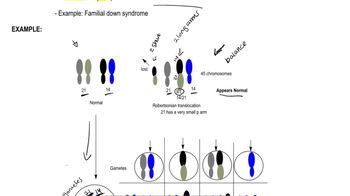A healthy couple with a history of three previous spontaneous abortions has just had a child with cri-du-chat syndrome, a disorder caused by a terminal deletion of chromosome 5. Their physician orders karyotype analysis of both parents and of the child. The karyotype results for chromosomes 5 and 12 are shown here. Do the karyotypes of the parents help explain the occurrence of the three previous spontaneous abortions? Explain.
Table of contents
- 1. Introduction to Genetics51m
- 2. Mendel's Laws of Inheritance3h 37m
- 3. Extensions to Mendelian Inheritance2h 41m
- 4. Genetic Mapping and Linkage2h 28m
- 5. Genetics of Bacteria and Viruses1h 21m
- 6. Chromosomal Variation1h 48m
- 7. DNA and Chromosome Structure56m
- 8. DNA Replication1h 10m
- 9. Mitosis and Meiosis1h 34m
- 10. Transcription1h 0m
- 11. Translation58m
- 12. Gene Regulation in Prokaryotes1h 19m
- 13. Gene Regulation in Eukaryotes44m
- 14. Genetic Control of Development44m
- 15. Genomes and Genomics1h 50m
- 16. Transposable Elements47m
- 17. Mutation, Repair, and Recombination1h 6m
- 18. Molecular Genetic Tools19m
- 19. Cancer Genetics29m
- 20. Quantitative Genetics1h 26m
- 21. Population Genetics50m
- 22. Evolutionary Genetics29m
6. Chromosomal Variation
Chromosomal Rearrangements: Deletions
Problem 32c
Textbook Question
A healthy couple with a history of three previous spontaneous abortions has just had a child with cri-du-chat syndrome, a disorder caused by a terminal deletion of chromosome 5. Their physician orders karyotype analysis of both parents and of the child. The karyotype results for chromosomes 5 and 12 are shown here. Why does this parent have a normal phenotype?
 Verified step by step guidance
Verified step by step guidance1
Understand the genetic basis of cri-du-chat syndrome: It is caused by a terminal deletion on the short arm of chromosome 5 (5p). This deletion leads to the loss of specific genes, resulting in the clinical features of the syndrome.
Review the concept of balanced chromosomal rearrangements: A parent may have a chromosomal rearrangement, such as a translocation, that is balanced. In a balanced rearrangement, no genetic material is lost or gained, so the individual typically has a normal phenotype.
Examine the karyotype results: Analyze the karyotype data provided for chromosomes 5 and 12. Look for evidence of a balanced translocation involving these chromosomes, which could explain why the parent has a normal phenotype despite the potential for genetic abnormalities.
Consider the inheritance mechanism: If the parent has a balanced translocation, they can pass on an unbalanced chromosomal arrangement to their offspring. This unbalanced arrangement could result in the terminal deletion on chromosome 5 observed in the child with cri-du-chat syndrome.
Conclude why the parent has a normal phenotype: The parent’s balanced translocation does not disrupt the function of their genes, allowing them to have a normal phenotype. However, the unbalanced chromosomal inheritance in the child leads to the clinical features of cri-du-chat syndrome.
 Verified video answer for a similar problem:
Verified video answer for a similar problem:This video solution was recommended by our tutors as helpful for the problem above
Video duration:
2mPlay a video:
Was this helpful?
Key Concepts
Here are the essential concepts you must grasp in order to answer the question correctly.
Cri-du-chat Syndrome
Cri-du-chat syndrome is a genetic disorder caused by a deletion of a portion of chromosome 5, specifically at the 5p15.2 region. This deletion leads to various developmental issues, including distinctive facial features, intellectual disability, and a high-pitched cry resembling a cat's meow. Understanding this syndrome is crucial for analyzing the genetic implications for the child and the parents.
Recommended video:
Guided course

Robertsonian Translocations
Karyotype Analysis
Karyotype analysis is a laboratory technique used to visualize an individual's chromosomes, allowing for the identification of chromosomal abnormalities such as deletions, duplications, or translocations. In this case, karyotyping can help determine whether the parents carry any chromosomal anomalies that could explain the child's condition or their own normal phenotypes despite a history of miscarriages.
Recommended video:
Guided course

Chi Square Analysis
Phenotype vs. Genotype
The phenotype refers to the observable characteristics or traits of an individual, while the genotype is the underlying genetic makeup. A parent may have a normal phenotype despite carrying a genetic mutation if the mutation is recessive or if they possess a normal allele that compensates for the abnormal one. This distinction is essential for understanding why one parent appears normal even if there are genetic concerns in the family history.
Recommended video:
Guided course

Gamete Genotypes
Related Videos
Related Practice
Textbook Question
325
views


